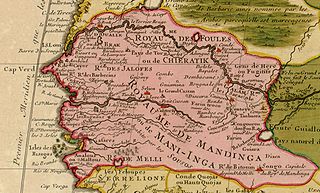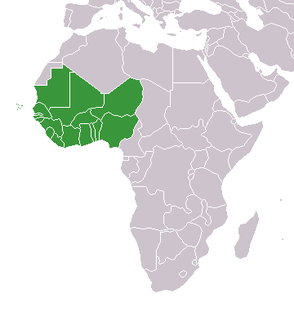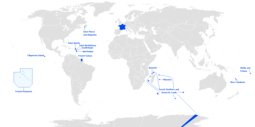Related Research Articles

Senegal, officially the Republic of Senegal, is a country in West Africa. Senegal is bordered by Mauritania in the north, Mali to the east, Guinea to the southeast, and Guinea-Bissau to the southwest. Senegal nearly surrounds The Gambia, a country occupying a narrow sliver of land along the banks of the Gambia River, which separates Senegal's southern region of Casamance from the rest of the country. Senegal also shares a maritime border with Cape Verde. Senegal's economic and political capital is Dakar.

The history of Senegal is commonly divided into a number of periods, encompassing the prehistoric era, the precolonial period, colonialism, and the contemporary era.

Dakar is the capital and largest city of Senegal. The city of Dakar proper has a population of 1,030,594, whereas the population of the Dakar metropolitan area is estimated at 3.94 million in 2021.

West Africa or Western Africa is the westernmost region of Africa. The United Nations defines Western Africa as the 16 countries of Benin, Burkina Faso, Cape Verde, The Gambia, Ghana, Guinea, Guinea-Bissau, Ivory Coast, Liberia, Mali, Mauritania, Niger, Nigeria, Senegal, Sierra Leone, and Togo as well as Saint Helena, Ascension and Tristan da Cunha. The population of West Africa is estimated at about 381 million people as of 2018, and at 381,981,000 as of 2017, of which 189,672,000 are female and 192,309,000 male. The region is demographically and economically one of the fastest growing on the African continent.

Biffeche or Bifeche is an area of Senegal centred on the town of Savoigne, around 30 kilometres north-east of the major coastal city of Saint-Louis.
A marabout is a Muslim religious leader and teacher who historically had the function of a chaplain serving as a part of an Islamic army, notably in North Africa and the Sahara, in West Africa, and (historically) in the Maghreb. The marabout is often a scholar of the Qur'an, or religious teacher. Others may be wandering holy men who survive on alms, Sufi Murshids ("Guides"), or leaders of religious communities.

Saint Louis or Saint-Louis, known to locals as Ndar, is the capital of Senegal's Saint-Louis Region. Located in the northwest of Senegal, near the mouth of the Senegal River, and 320 km north of Senegal's capital city Dakar, it has a population officially estimated at 258,592 in 2021. Saint-Louis was the capital of the French colony of Senegal from 1673 until 1902 and French West Africa from 1895 until 1902, when the capital was moved to Dakar. From 1920 to 1957, it also served as the capital of the neighboring colony of Mauritania.

Louis Léon César Faidherbe was a French general and colonial administrator. He created the Senegalese Tirailleurs when he was governor of Senegal.

Île de Gorée is one of the 19 communes d'arrondissement of the city of Dakar, Senegal. It is an 18.2-hectare (45-acre) island located 2 kilometres at sea from the main harbour of Dakar, famous as a destination for people interested in the Atlantic slave trade although its actual role in the history of the slave trade is the subject of dispute.

Rufisque is a city in the Dakar region of western Senegal, at the base of the Cap-Vert Peninsula. It has a population of 179,797. In the past it was an important port city in its own right, but is now a suburb of Dakar.
The French conquest of Senegal started in 1659 with the establishment of Saint-Louis, Senegal, followed by the French capture of the island of Gorée from the Dutch in 1677, but would only become a full-scale campaign in the 19th century.

Women in Senegal have a traditional social status as shaped by local custom and religion. According to 2005 survey, the female genital mutilation prevalence rate stands at 28% of all women in Senegal aged between 15 and 49.
The Serer religion, or a ƭat Roog, is the original religious beliefs, practices, and teachings of the Serer people of Senegal in West Africa. The Serer religion believes in a universal supreme deity called Roog. In the Cangin languages, Roog is referred to as Koox, Kopé Tiatie Cac, and Kokh Kox.
Lamane or laman means "master of the land" in the Mandingue, Wolof, and Serer languages. The name was also sometimes the title of chiefs or kings of the Serer people of the Senegambia region which includes modern day Senegal and the Gambia. This title was also used by some kings of the Wolof kingdoms. The title is sometimes used interchangeably with the old title Maad. After the Guelowars' migration to the Sine and the foundation of the Kingdom of Sine, "lamane" denotes a provincial chiefs answerable to the King of Sine and Saloum.
Lamane Jegan Joof, was a Serer lamane who according to Serer tradition founded the Serer village of Tukar now part of present-day Senegal. The Raan Festival takes place each year at Tukar, two weeks after the appearance of the new moon in April.

The Point of Sangomar is a sand spit located on the Atlantic Ocean at the mouth of the Saloum Delta, which marks the end of the Petite Côte west of Senegal.

Lingeer was the title given to the mother or sister of a king in the Serer kingdoms of Sine, Saloum, and previously the Kingdom of Baol; and the Wolof kingdoms of Cayor, Jolof, Baol and Waalo in pre-colonial Senegal. The word "Lingeer" means "queen" or "princess" in Serer and Wolof language. The Lingeer was considered the “great princess of royal courts.” These kingdoms utilized a bilineal system, as a candidate for kingship could not succeed to the throne if he was not a member of the reigning materlineage, and thus, the Lingeer's maternal lineage was highly significant. In similarity, a candidate could not succeed to the throne as king if he was not a member of the noble reigning patriclans. That was particular so among the Serer who retained much of their old culture, customs and traditional religion where women played a significant role compared to the Wolof who adopted Islam. Various Lingeers have been noted for their resistance efforts to colonial conquest.
The following is a timeline of the history of the city of Dakar, Senegal.
The following is a timeline of the history of the city of Saint-Louis, Senegal.

Senegalese nationality law is regulated by the Constitution of Senegal, as amended; the Nationality Law, and its revisions; and various international agreements to which the country is a signatory. These laws determine who is, or is eligible to be, a national of Senegal. The legal means to acquire nationality, formal legal membership in a nation, differ from the domestic relationship of rights and obligations between a national and the nation, known as citizenship. Nationality describes the relationship of an individual to the state under international law, whereas citizenship is the domestic relationship of an individual within the nation. Senegalese nationality is typically obtained under the principal of jus sanguinis, i.e. by birth in Senegal or abroad to parents with Senegalese nationality. It can be granted to persons with an affiliation to the country, or to a permanent resident who has lived in the country for a given period of time through naturalization.
References
- ↑ Rogers, Dominique; Stewart, King (2012). "Housekeepers, merchants, rentières: free women of color in the port cities of colonial Saint-Domingue, 1750–1790". In Catterall, Douglas; Campbell, Jodi (eds.). Women in Port: Gendering Communities, Economies, and Social Networks in Atlantic Port Cities, 1500-1800. Leiden: Brill. p. 384. ISBN 9789004233171 . Retrieved 12 February 2017.
- ↑ Lecuir-Nemo, Geneviève (1998). Femmes et vocation missionnaire : permanence des congrégations féminines au Sénégal de 1819 à 1960 : adaption ou mutations? : impact et insertion (in French). Villeneuve d'Ascq: Presses Universitaire du Septentrion. p. 122 fn5. ISBN 2-284-002250.
- Rulers.org: Senegal
- Lucie Gallistel Colvin. Historical Dictionary of Senegal. Scarecrow Press/ Metuchen. NJ–London (1981) ISBN 0-8108-1885-X pp. 81–98 (Table 10).
